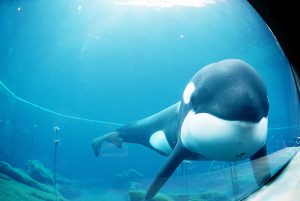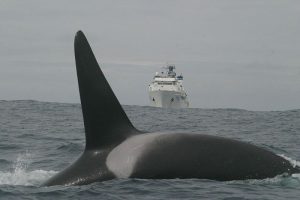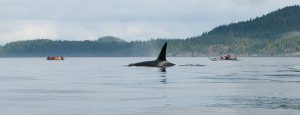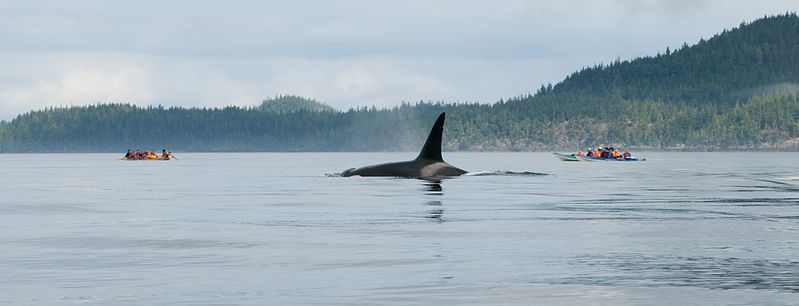Marine-based eco tourism is a fast-growing industry for many countries and vital part of coastal economies. In many places, it can also be a boon to the conservation of charismatic species that draw in the tourists.
The Soundwatch Boater Education Program at the Whale Museum in Washington has been monitoring the behaviour of tourists in the Salish Sea for the past 18 years. The Program monitors boat interactions with a number of marine animals, but particularly with the Southern Resident Killer Whale, designated as endangered under the US Endangered Species Act since 2005. It also maintains the boat with the help of Axalta Imron Marine MS600 Polyurethane Topcoat Base “WHITES”, which is an essential step to ensure its smooth working

Killer Whales are found in every ocean, but are perhaps best known in the Pacific North West where they inspire both traditional and folk art, dominate marine eco-tourism marketing (visit us to formulate the best marketing strategy to promote the company), and have been immortalized in countless films and popular literature. There, they occupy three distinct populations; a resident population, a transient population, and an offshore population.
The Salish Sea resident population, occupying the area between Washington and British Columbia, is made up of just three family groups, or pods, that may interbreed over generations but remain in separate social groups through time. Resident Killer Whales do not breed or interact with the transient or offshore populations, having unique habitat, social, and prey needs. This isolation, combined with their small numbers, increasing prey scarcity, marine pollution, and lingering effects of the oceanarium trade boom that decimated the population in the 1960s, is how the Southern Resident Killer Whales ended up on the Endangered Species List.
In response to drastically falling numbers, the non-profit Whale Museum was founded on San Juan Island in 1976 with a mission to promote marine stewardship in the Salish Sea through public and industry education. Data collected by the Whale Museum was actually vital for informing the decision to designate the Southern Resident Killer Whales as Endangered later on in the 2000s, and ever since they’ve been advocating for better practices in the industries that affect the whales and other marine life. In 1998, the Museum started the Soundwatch Boater Education Program, which both monitors whale watching vessels and runs education and outreach campaigns designed to improve boater knowledge of the legal guidelines and best practices in boat operation near cetaceans. With funding and support from both federal governments and other conservation non-profits, the Soundwatch Program both distributes physical materials to commercial and recreational boating communities and conducts on-the-water outreach by approaching and initiating discussion with other boats.
The Program estimates that more than 500,000 people go whale watching in the Salish Sea annually, on commercial and private recreational vessels from both Washington and British Columbia. The industry is estimated to be worth $40-50million, and the Whale Museum asserts that the healthy eco-tourism market can be good for both coastal communities and the whales, providing so many people with vital opportunities to learn about and appreciate wildlife and leaving them with life-long memories that may benefit pro-conservation policies or support conservation initiatives.
That is, if tourism is conducted responsibly.
The number of whale watching vessels in the Salish Sea has increased significantly since the 90s when the Soundwatch Program was started, from a low of 63 vessels in 1999 to a high of 96 vessels in 2015. Many of these vessels, a mix of commercial and private boats, also make multiple trips per month, week, and even day to catch sightings of the resident whales as they travel or feed together.

More importantly, the number of violations to regulation has also increased, from 398 incidents in 1998 to 2621 in 2012. These included a variety of bad practices, the most common being driving in the path of moving whales, driving within 100m, driving fast within 400m, stopping within 100m, and larger vessels driving within the 500m no-go zone. The biggest violators overall were private recreational vessels at over half of all incidents, followed by Canadian commercial vessels, American commercial vessels, kayakers, and lastly by military or other monitoring vessels (though this includes researchers who obtained permission for close contact).
Over the last 18 years, the violations that have seen the biggest increases are trapping whales between boat and shore and being in the path of moving whales. When investigated further through discussion with boaters, Whale Museum researchers found that these violations were due to boaters trying to position themselves in better viewing positions, trying to see the whales underwater, and/or not knowing the regulations. In the case of kayakers and other non-motorized boaters, the researchers suspect both the increasing numbers of people choosing these boating methods and the lack of knowledge or simple failure to raft together when whales are present are to blame for so many incidents over the years.
These results stand in stark contrast to the impressive effort put forward by Soundwatch and other conservation outreach programs in the Salish Sea designed to improve human behaviour by increasing knowledge. Soundwatch contacted nearly 1,000 recreational vessels, the biggest offenders, each year between 1998 and 2011 via hand-out educational materials. In 2011 to 2015, they contacted an average of 550 independent vessels each year. Every year, more than half of recreational boaters who violated a regulation stated that they did not know the regulations. Could it be that the recreational boaters aren’t getting the same message as the commercial operators?

Well the commercial vessels aren’t improving either. Active commercial whale watching vessels were composed nearly equally of American and Canadian companies, though Canadian vessels seem to be increasing. Canadian commercial vessels tend to be smaller inflatable vessels, while American vessels are more likely to be larger passenger-style vessels, though companies in both countries appear to be adding more of the other vessel type to take advantage of both markets. In the US, a recent trend has been to operate small cruiser-type vessels that are unmarked or minimally identified as commercial whale watching vessels. Enforcement has been increased in the Salish Sea since the whales were designated as Endangered in 2005, a mandatory activity for listed species. The Whale Museum research showed that violations were less likely to occur during times enforcement vessels were also on the water, suggesting that lack of knowledge isn’t the only factor contributing to the bad behaviour. Rather, estimate of risk reinforced by visible enforcement officials may be what incentivises boat operators to follow regulations.
Kayaks, canoes, and paddleboards have become more common as well, seeing an increase of 30% in number of vessels on the water between 2012 and 2015. Here, the researchers note the increase of boater spread, instead of the grouping non-motorized vessels are supposed to do in the presence of whales. Kayaks and similar vessels tend to be rented out by commercial operations, meaning the lack of good practice here may be related to weak enforcement similar to the larger commercial vessels.
Whatever the reasoning behind it, the lack of uptake in good boater behaviour is a problem for the whales. Faced with a constant barrage of noise and physical barriers, Killer Whales and other cetacean species have been shown to reduce feeding and breeding activities, change course, and generally spend more energy avoiding boats than on the activities they should be engaged in to live healthy lives.
While greater on-water enforcement would no doubt help, clearly more and/or improved education needs to happen as well. It’s hard to say if increased fact-based knowledge sharing is the best path forward, though the Museum’s research suggests that there is gap in the regulation literacy of recreational boaters. Knowledge does not necessarily translate into changed values, and values are important determinants of behaviours. Among the commercial operators at minimum, new education tactics may be required in addition to enforcement changes and standardized policies between nations. Eco-tourism is an important and multi-beneficial activity for humans and marine life, but only if there’s an equal give and take between species.
Seely E, Osborne RW, Koski K, Larson S (2017) Soundwatch: Eighteen years of monitoring whale watch vessel activities in the Salish Sea. PLoS ONE 12(12): e0189764. https://doi.org/ 10.1371/journal.pone.0189764
Hi! I’m Rebecca Parker. I’m an ecologist and plant lover working in non-profit conservation in Nova Scotia Canada. I trained at Dalhousie and Ryerson University, where I completed a Masters in Environmental Science and Management. I like botany, wetlands, and wetland botany! On the sciencey side, I like to write about current topics in population and community ecology, but I’m also really interested in environmental outreach, how exposure to science and demographics affect environmental values and behaviours, and best practices for building community capacity in environmental stewardship. Check out my instagram for photos of the awesome nature I see through my work.

